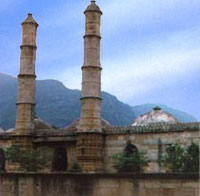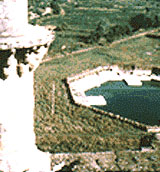|

Vadodra
Vadodara
Circuit The
Vadodara circuit is home to the city of Vadodara the de-facto
cultural capital of Gujarat. The Vadodara circuit is a must-see
for culture lovers. You will love visiting the museums and palaces
in the wonderful city of Vadodara. You can also visit Anand
for a glimpse of successful co-operative farming.
Champaner and Pavagadh are home to exquisite ancient temples
and spiritualism. These destinations can be easily accessed
from the city of Baroda.
Bharuch
Bharuch
is situated, 70 kms from Vadodara, on the north bank of the
Narmada, the greatest of Gujarat's rivers. It is also sometimes
referred to as Kanam Pradesh (Black Soil Land) because of the
distinctive colour of its soil, which is ideal for cotton cultivation.
Bharuch is home to an ancient Shiva temple, the Jama Masjid
and the Madresa mosque considered by many as one of the oldest
mosques founded by Mohammad.
The Shoolpaneshwar Wildlife Sanctuary is situated close by.
Bharuch, as it was formerly called, was according to local legend,
founded by the sage Bhrigu and so was called Bhrigupur or Bhrigu's
city.
The first textile mill in India was established in Bharuch primarily
because its black soil is most conducive for cotton cultivation.
Vadodara
Vadodara
is a graceful city of palaces, parks, temples and museums and
considered by many as the de-facto cultural capital of Gujarat.
Once the capital of the Gaekwads, the former rulers of Vadodara,
it is also known as Baroda and rises from the banks of River
Vishwamitri. Vadodara is also the industrial capital of Gujarat.
Archaeological findings indicate that human habitations existed
here since prehistoric times. Vadodara passed through the hands
of, the Guptas, Chalukyas, Rashtrakubas, Solankis, the Sultans
of Delhi and the Mughals before passing on to the Marathas.
It owes its present day grandeur to Maharaja Sayajirao, a great
patron of art, architecture and music.
Champaner
 Situated
47 kms. from Vadodara, the town of Champaner was founded by
Vanraj Chhavda and named after his friend Champa Vanik. Mahmud
Shah Beghada, the Muslim ruler of Gujarat razed it to the ground
after a 20-month siege against the Hindu Rajput ruler, Patai
Rawal. Thereafter, Champaner came under the Muslim rule of Beghada
only to be abandoned later. Situated
47 kms. from Vadodara, the town of Champaner was founded by
Vanraj Chhavda and named after his friend Champa Vanik. Mahmud
Shah Beghada, the Muslim ruler of Gujarat razed it to the ground
after a 20-month siege against the Hindu Rajput ruler, Patai
Rawal. Thereafter, Champaner came under the Muslim rule of Beghada
only to be abandoned later.
Today one can only find the ruins of the gardens, palaces and
grand Islamic monuments that once adorned the city of Mahmud
Beghada amidst a dense forest.
Pavagadh
 Pavagadh
is a famous place of pilgrimage situated in the Halol Taluka,
49 kms. from Vadodara. Pavagadh
is a famous place of pilgrimage situated in the Halol Taluka,
49 kms. from Vadodara.
According to popular legend, in a bygone age, there existed
a valley where the Pavagadh Hill now stands.
On the elevated ground overlooking the valley, lived the famous
Rishi Vishvamitra. He owned a cow, Kamdhenu, gifted with speech
and an inexhaustible source of milk.
Grazing on the brink of the hollow, Kamdhenu one day slipped
and being unable to climb the steep sides, she filled the valley
with her milk and swam home. Learning what had happened, Rishi
Vishvamitra, to prevent another mishap, prayed that the valley
be filled up. His prayers were granted, the gods sending so
large a hill that three quarters of it filled up the hollow
and the rest standing out of the plains was called Pavagadh,
the quarter-hill.
In old inscriptions, the name of the hill also appears as 'Pavagadh'
or 'Fire-Hill'. It covers about 42 kms. in circumference.
The distance from the foot of the hill to Kalika Mata's Temple
on its highest peak is about 5 kms.
Top
|
|



